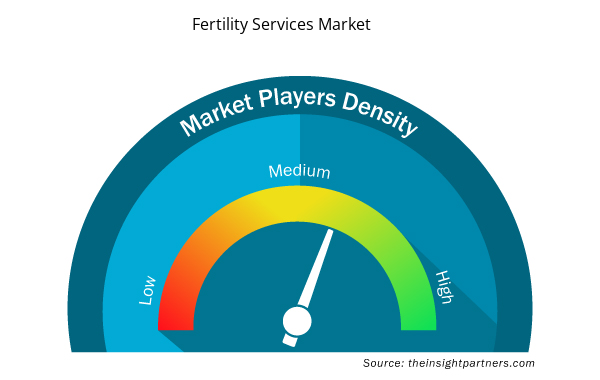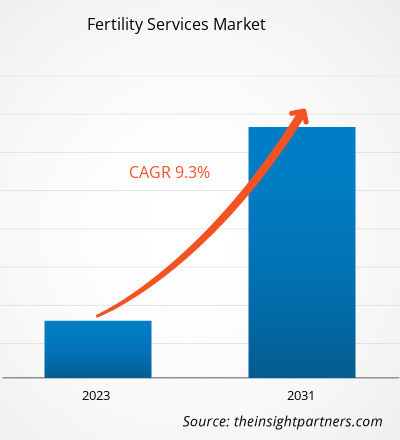[調査レポート] 不妊治療サービス市場の予測は、2023年の329.9億米ドルから2031年には671.2億米ドルに成長すると予測されており、市場は2023年から2031年の間に9.3%のCAGRを記録すると推定されています。
市場洞察とアナリストの見解:
不妊治療サービス市場規模の拡大に寄与している要因としては、医療施設のアクセスと利用可能性の向上、精子の形態不良、運動性不良、精子数が少ない男性における ICSI を使用した体外受精 (IVF) の成功率の向上、医療費と研究費の増加などが挙げられます。さらに、多嚢胞性卵巣症候群 (PCOS)、子宮内膜結核、性感染症 (STD) など、不妊症の原因となる医学的疾患の罹患率の増加も、市場の成長を牽引しています。不妊症に関する意識の高まりと、より優れた医療施設へのアクセスの容易化により、先進国と新興国におけるこれらのサービスに対する需要も高まっています。不妊症関連疾患の症例増加は、近年、世界市場を後押ししています。市場の成長に寄与しているその他の要因としては、可処分所得の増加、健康保険会社による柔軟な補償オプションの利用可能性、テレビやインターネット ポータルを通じた生殖サービスに関する広告とプロモーションの増加などが挙げられます。また、このレポートには、不妊治療サービスの開始と承認の増加や技術の進歩など、現在の不妊治療サービス市場の動向を踏まえた成長見通しも含まれています。
成長の原動力:
婦人科疾患の罹患率増加が市場の成長を促進
性感染症(STI)の未治療や中絶失敗、産後敗血症、腹部/骨盤手術の結果によって引き起こされる卵管閉塞などの卵管異常は、女性の不妊症につながる可能性があります。子宮内膜結核、PCOS、STDなど、不妊症につながる可能性のあるさまざまな病気の発生率の増加は、不妊治療サービス市場の拡大を促進しています。2022年8月に発行されたCureus Journalによると、女性人口におけるPCOSの世界的有病率は4〜20%と推定されています。世界保健機関(WHO)は、2021年に世界中で1億1600万人以上の女性(3.4%)がPCOSに罹患していると推定しました。さらに、2020年のLancetの記事によると、中国でPCOSに苦しんでいる女性の数は2400万人と推定されています。したがって、この要因により、女性に対する体外受精(IVF)やさまざまな生殖補助技術(ART)の需要が高まり、不妊治療サービス市場の成長が促進されます。
要件に合わせてレポートをカスタマイズする
このレポートの一部、国レベルの分析、Excelデータパックなど、あらゆるレポートを無料でカスタマイズできます。また、スタートアップや大学向けのお得なオファーや割引もご利用いただけます。
- このレポートの主要な市場動向を入手してください。この無料サンプルには、市場動向から見積もりや予測に至るまでのデータ分析が含まれます。
レポートのセグメンテーションと範囲:
不妊治療サービス市場の分析は、手順、患者タイプ、エンドユーザー、および地域に基づいて行われます。手順に基づく市場は、生殖補助技術、人工授精、および不妊治療手術に分割されます。患者タイプに基づく市場は、男性と女性に分かれています。エンドユーザーの観点から、不妊治療サービス市場は、不妊治療センター、病院および外科クリニック、およびその他の分野に分割されます。
セグメント分析:
不妊治療サービス市場は、手順に基づいて、生殖補助技術、人工授精、不妊治療手術に分類されます。生殖補助技術セグメントは、2023年に最大の市場シェアを占めました。2023年から2031年の間に最高のCAGRを記録すると予想されています。生殖補助技術セグメントの市場は、体外受精、卵細胞質内精子注入、代理出産にさらに分類されます。
不妊治療サービス市場は、患者タイプ別に、男性と女性に分かれています。2023年には女性セグメントがより大きな市場シェアを占めました。しかし、予測期間中は男性セグメントの方が高いCAGRを記録すると予想されています。男性不妊の原因としては、ストレスレベルの増加、肥満、喫煙、アルコール消費などが挙げられます。さらに、不妊治療サービスに関する意識の高まり、研究開発費の増加、主要市場プレーヤーによる製品発売の取り組み、ライフスタイルの変化が、男性セグメントの市場成長を後押ししています。
エンドユーザーの観点から見ると、不妊治療サービス市場は、不妊治療センター、病院および外科クリニック、その他に分類されます。不妊治療センターセグメントは2023年に最大の市場シェアを占め、2023年から2031年の間に最高のCAGRを記録すると予想されています。世界中の不妊治療クリニックの数の増加は、技術の進歩と相まって、このセグメントの世界的な市場成長を後押しします。さらに、先進国と新興国の人々の不妊治療に対する認識は急速に高まっています。これにより、世界中の不妊治療クリニックの数が増加し、このセグメントの世界的な市場成長が促進されます。さらに、不妊を治療できる専門家の数の増加、可処分所得の増加、インド、中国などの発展途上国での認可された不妊治療クリニックの数の急増も、不妊治療センターセグメントの成長を後押ししています。
地域分析 - 不妊治療サービス市場:
不妊治療サービス市場レポートの対象範囲は、北米(米国、カナダ、メキシコ)、欧州(スペイン、英国、ドイツ、フランス、イタリア、その他の欧州)、アジア太平洋(韓国、中国、インド、日本、オーストラリア、その他のアジア太平洋)、中東およびアフリカ(南アフリカ、サウジアラビア、UAE、その他の中東およびアフリカ)、南米および中米(ブラジル、アルゼンチン、その他の南米および中米)です。アジア太平洋地域は、いくつかの不妊治療薬の導入と急速な普及、および不妊研究活動の増加により、2023年に最大の市場シェアを占めました。
ヨーロッパは、2023年に不妊治療サービス市場で第3位のシェアを占めました。この地域の市場は、ドイツ、英国、イタリア、スペイン、フランス、その他のヨーロッパに分割されています。多数の国内市場プレーヤーの存在と不妊症の発生率の増加は、この地域の市場成長を牽引する主な要因の1つです。ドイツは、この地域市場への主要な貢献者の1つです。ヨーロッパは世界中のIVFクリニックの40%をホストしており、これがヨーロッパの不妊検査および治療市場の成功の重要な要因であることが証明されています。さらに、この地域は世界のリーダーからの多額の投資を見てきました。ヨーロッパ市場の全体的な見通しは有望であり、優れたIVF技術はプライベートエクイティ投資家からの多額の投資を集めています。さらに、自分で行う検査によりアクセスが向上し、不妊検査と治療のコストが削減されました。両方の要因により、今後数年間で不妊治療サービス市場の成長に有利な機会がもたらされると予想されます。
アジア太平洋地域の不妊治療サービス市場は、2021年から2031年にかけてXX%という最速のCAGRを記録すると予想されています。APACの市場は、中国、日本、インド、オーストラリア、韓国、その他のAPACに分割されています。中国の市場は、医療ツーリズムの増加と医療インフラの改善により成長しており、この地域での不妊治療サービスの採用が増加すると予想されています。さらに、市場プレーヤーによるさまざまな不妊治療サービスの開発における技術的進歩が、この地域の市場の成長を牽引すると予想されています。製品の発売の増加とハイテク不妊治療サービスの承認の増加は、今後数年間で地域の市場成長を後押しすると予想されます。この地域の不妊率の上昇、妊娠の遅れ、体外受精の成功率の上昇、可処分所得の増加により、アジア太平洋地域の市場は予測期間中に大幅に成長すると予想されます。体外受精は、シングルマザー、カップル、LGBTコミュニティのメンバーなど、不妊に悩む人々を支援するために最も一般的に使用されている方法の1つです。さらに、アジア太平洋地域の体外受精治療市場は、不妊治療ツーリズムの急増により、持続可能な発展の可能性を秘めています。さらに、不妊治療クリニックの数の増加と新興地域での拡大の可能性により、市場の成長が促進されると予想されます。
不妊治療サービス市場の地域別洞察
予測期間を通じて不妊治療サービス市場に影響を与える地域的な傾向と要因は、Insight Partners のアナリストによって徹底的に説明されています。このセクションでは、北米、ヨーロッパ、アジア太平洋、中東、アフリカ、南米、中米にわたる不妊治療サービス市場のセグメントと地理についても説明します。

- 不妊治療サービス市場の地域別データを入手
不妊治療サービス市場レポートの範囲
| レポート属性 | 詳細 |
|---|---|
| 2023年の市場規模 | 329.9億米ドル |
| 2031年までの市場規模 | 671.2億米ドル |
| 世界のCAGR(2023年~2031年) | 9.3% |
| 履歴データ | 2021-2023 |
| 予測期間 | 2023-2031 |
| 対象セグメント | 手順別
|
| 対象地域と国 | 北米
|
| 市場リーダーと主要企業プロフィール |
|
不妊治療サービス市場のプレーヤー密度:ビジネスダイナミクスへの影響を理解する
不妊治療サービス市場は、消費者の嗜好の変化、技術の進歩、製品の利点に対する認識の高まりなどの要因により、エンドユーザーの需要が高まり、急速に成長しています。需要が高まるにつれて、企業は提供内容を拡大し、消費者のニーズを満たすために革新し、新たなトレンドを活用し、市場の成長をさらに促進しています。
市場プレーヤー密度とは、特定の市場または業界内で活動している企業または会社の分布を指します。これは、特定の市場スペースに、その市場規模または総市場価値に対してどれだけの競合相手 (市場プレーヤー) が存在するかを示します。
不妊治療サービス市場で事業を展開している主要企業は次のとおりです。
- クーパーサージカル株式会社
- ビトロライフ
- クックメディカル
- ケア 不妊治療
- INVOバイオサイエンス
免責事項:上記の企業は、特定の順序でランク付けされていません。

- 不妊治療サービス市場のトップキープレーヤーの概要を入手
業界の発展と将来の機会 – 不妊治療サービス市場:
不妊治療サービス市場で活動する大手企業のプレスリリースによると、いくつかの取り組みが以下に挙げられています。
- 2022年10月、インディラIVFは、遠隔医療ベースのバーチャルクリニックの支援を受けて女性と家族の健康を専門とする米国企業であるMaven Clinicと提携しました。この提携の目的は、インドのMaven会員に、インディラIVFの高品質な臨床ケア、その他の特典、そしてMavenプラットフォームを通じて利用できる最高のバーチャル家族教育ケアへのアクセスを提供することです。インディラIVFは、インドを拠点とする不妊治療専門クリニックのチェーンです。
- 2022 年 8 月、Genea Fertility は、オーストラリア ユダヤ人不妊治療ネットワーク (AJFN) の年次大規模募金活動のプラチナ スポンサーとなりました。
- 2021 年 12 月、女性の健康ソリューションの大手プロバイダーである Cooper Surgical が、Generate Life Sciences を 16 億米ドルで買収しました。この買収により、Cooper Surgical は、不妊治療センターと産婦人科センターの選択肢をさらに広げます。Generate Life Sciences は、不妊治療凍結保存サービス、不妊治療センター、新生児幹細胞保管にドナーの卵子と精子を提供する米国を拠点とする企業です。
- 2021年7月、ART研究の世界的プロバイダーであるHamilton Throne Ltd.は、IVFTECH ApS(IVFtech)とその子会社K4 Technology ApSを買収しました。K4、IVFtechは、ART用の大容量の層流ワークステーションとインキュベーターを提供することに注力しています。買収額は800万米ドルでした。
- 2021年5月、生殖補助医療(ARS)の世界的リーダーであるVirtus Healthは、慢性炎症に焦点を当てたオーストラリアのバイオテクノロジーおよびデジタルヘルス企業であるDrop Bioとの戦略的提携を発表し、精密不妊治療の実現の進歩を推進しています。
- 2021 年 2 月、女性の健康ソリューションの大手プロバイダーである Cooper Surgical は、不妊治療におけるイノベーション、デジタル化、進歩を推進するために、生殖補助医療サービスの世界的リーダーである Virtus Health との複数年にわたる戦略的提携を発表しました。
- 2020年11月、Ferring BVとIgenomixは、妊娠関連疾患に罹患した患者を治療するための新たな治療製品の開発を目的として、4年間の研究協力契約を締結しました。
競争環境と主要企業 – 不妊治療サービス市場:
CooperSurgical, Inc.、Vitrolife、Cook Medical、Care Fertility、INVO Bioscience、Carolinas Fertility Institute、Genea Limited、Merck KgaA、LABOTECT GmbH、およびMonash IVF Group Limitedは、不妊治療サービス市場レポートで紹介されている主要な市場プレーヤーです。これらの企業は、世界中で高まる消費者の需要を満たすために、新しいテクノロジー、既存製品の進歩、および地理的拡大に重点を置いています。
- 過去2年間の分析、基準年、CAGRによる予測(7年間)
- PEST分析とSWOT分析
- 市場規模価値/数量 - 世界、地域、国
- 業界と競争環境
- Excel データセット


- Asset Integrity Management Market
- Energy Recovery Ventilator Market
- Advanced Planning and Scheduling Software Market
- Queue Management System Market
- Investor ESG Software Market
- Occupational Health Market
- Health Economics and Outcome Research (HEOR) Services Market
- Tortilla Market
- Adaptive Traffic Control System Market
- Smart Locks Market

Report Coverage
Revenue forecast, Company Analysis, Industry landscape, Growth factors, and Trends

Segment Covered
This text is related
to segments covered.

Regional Scope
North America, Europe, Asia Pacific, Middle East & Africa, South & Central America

Country Scope
This text is related
to country scope.
よくある質問
The fertility services market is analyzed on the basis of procedure, patient type, end user. Based on procedure, the fertility services market is segmented into assisted reproductive technology, artificial insemination, and fertility surgeries. The assisted reproductive technology segment accounted for the largest market share in 2023. It is expected to register the highest CAGR during 2023–2031. The fertility services market, by patient type, is bifurcated into male and female. The female segment held a larger market share in 2023. However, the male segment is anticipated to register a higher CAGR during the forecast period. In terms of end user, the fertility services market is segmented into fertility centers, hospitals & surgical clinics, and others. The fertility centers segment held the largest market share in 2023 and is anticipated to register the highest CAGR during 2023–2031.
The fertility services market majorly consists of the players such as CooperSurgical, Inc.; Vitrolife: Cook Medical: Care Fertility: INVO Bioscience: Carolinas Fertility Institute: Genea Limited: Merck KgaA: LABOTECT GmbH: and Monash IVF Group Limited.
Treatments for genetic disorders and infertility problems are part of fertility services to aid conception. The development of assisted reproductive technologies (ART) such as intracytoplasmic sperm injection (ICSI) and in vitro fertilization (IVF) is one of the most significant developments in the fertility services market. These techniques have revolutionized reproductive medicine by making conceiving an embryo outside the body possible, thereby increasing the likelihood of a healthy pregnancy. Other advances include pre-implantation genetic testing, embryo cryopreservation, and egg freezing, providing additional options for couples and individuals pursuing fertility treatments.
The growing social and environmental factors and increasing prevalence of gynecological conditions contribute to the growing fertility services market size. However, high costs associated with fertility services hinder the market growth.
Trends and growth analysis reports related to Life Sciences : READ MORE..
The List of Companies - Fertility Services Companies
- CooperSurgical, Inc
- Vitrolife
- Cook Medical
- Care Fertility
- INVO Bioscience
- Carolinas Fertility Institute
- Genea Limited
- Merck KgaA
- LABOTECT GmbH
- Monash IVF Group Limited
The Insight Partners performs research in 4 major stages: Data Collection & Secondary Research, Primary Research, Data Analysis and Data Triangulation & Final Review.
- Data Collection and Secondary Research:
As a market research and consulting firm operating from a decade, we have published and advised several client across the globe. First step for any study will start with an assessment of currently available data and insights from existing reports. Further, historical and current market information is collected from Investor Presentations, Annual Reports, SEC Filings, etc., and other information related to company’s performance and market positioning are gathered from Paid Databases (Factiva, Hoovers, and Reuters) and various other publications available in public domain.
Several associations trade associates, technical forums, institutes, societies and organization are accessed to gain technical as well as market related insights through their publications such as research papers, blogs and press releases related to the studies are referred to get cues about the market. Further, white papers, journals, magazines, and other news articles published in last 3 years are scrutinized and analyzed to understand the current market trends.
- Primary Research:
The primarily interview analysis comprise of data obtained from industry participants interview and answers to survey questions gathered by in-house primary team.
For primary research, interviews are conducted with industry experts/CEOs/Marketing Managers/VPs/Subject Matter Experts from both demand and supply side to get a 360-degree view of the market. The primary team conducts several interviews based on the complexity of the markets to understand the various market trends and dynamics which makes research more credible and precise.
A typical research interview fulfils the following functions:
- Provides first-hand information on the market size, market trends, growth trends, competitive landscape, and outlook
- Validates and strengthens in-house secondary research findings
- Develops the analysis team’s expertise and market understanding
Primary research involves email interactions and telephone interviews for each market, category, segment, and sub-segment across geographies. The participants who typically take part in such a process include, but are not limited to:
- Industry participants: VPs, business development managers, market intelligence managers and national sales managers
- Outside experts: Valuation experts, research analysts and key opinion leaders specializing in the electronics and semiconductor industry.
Below is the breakup of our primary respondents by company, designation, and region:

Once we receive the confirmation from primary research sources or primary respondents, we finalize the base year market estimation and forecast the data as per the macroeconomic and microeconomic factors assessed during data collection.
- Data Analysis:
Once data is validated through both secondary as well as primary respondents, we finalize the market estimations by hypothesis formulation and factor analysis at regional and country level.
- Macro-Economic Factor Analysis:
We analyse macroeconomic indicators such the gross domestic product (GDP), increase in the demand for goods and services across industries, technological advancement, regional economic growth, governmental policies, the influence of COVID-19, PEST analysis, and other aspects. This analysis aids in setting benchmarks for various nations/regions and approximating market splits. Additionally, the general trend of the aforementioned components aid in determining the market's development possibilities.
- Country Level Data:
Various factors that are especially aligned to the country are taken into account to determine the market size for a certain area and country, including the presence of vendors, such as headquarters and offices, the country's GDP, demand patterns, and industry growth. To comprehend the market dynamics for the nation, a number of growth variables, inhibitors, application areas, and current market trends are researched. The aforementioned elements aid in determining the country's overall market's growth potential.
- Company Profile:
The “Table of Contents” is formulated by listing and analyzing more than 25 - 30 companies operating in the market ecosystem across geographies. However, we profile only 10 companies as a standard practice in our syndicate reports. These 10 companies comprise leading, emerging, and regional players. Nonetheless, our analysis is not restricted to the 10 listed companies, we also analyze other companies present in the market to develop a holistic view and understand the prevailing trends. The “Company Profiles” section in the report covers key facts, business description, products & services, financial information, SWOT analysis, and key developments. The financial information presented is extracted from the annual reports and official documents of the publicly listed companies. Upon collecting the information for the sections of respective companies, we verify them via various primary sources and then compile the data in respective company profiles. The company level information helps us in deriving the base number as well as in forecasting the market size.
- Developing Base Number:
Aggregation of sales statistics (2020-2022) and macro-economic factor, and other secondary and primary research insights are utilized to arrive at base number and related market shares for 2022. The data gaps are identified in this step and relevant market data is analyzed, collected from paid primary interviews or databases. On finalizing the base year market size, forecasts are developed on the basis of macro-economic, industry and market growth factors and company level analysis.
- Data Triangulation and Final Review:
The market findings and base year market size calculations are validated from supply as well as demand side. Demand side validations are based on macro-economic factor analysis and benchmarks for respective regions and countries. In case of supply side validations, revenues of major companies are estimated (in case not available) based on industry benchmark, approximate number of employees, product portfolio, and primary interviews revenues are gathered. Further revenue from target product/service segment is assessed to avoid overshooting of market statistics. In case of heavy deviations between supply and demand side values, all thes steps are repeated to achieve synchronization.
We follow an iterative model, wherein we share our research findings with Subject Matter Experts (SME’s) and Key Opinion Leaders (KOLs) until consensus view of the market is not formulated – this model negates any drastic deviation in the opinions of experts. Only validated and universally acceptable research findings are quoted in our reports.
We have important check points that we use to validate our research findings – which we call – data triangulation, where we validate the information, we generate from secondary sources with primary interviews and then we re-validate with our internal data bases and Subject matter experts. This comprehensive model enables us to deliver high quality, reliable data in shortest possible time.


 このレポートの無料サンプルを入手する
このレポートの無料サンプルを入手する